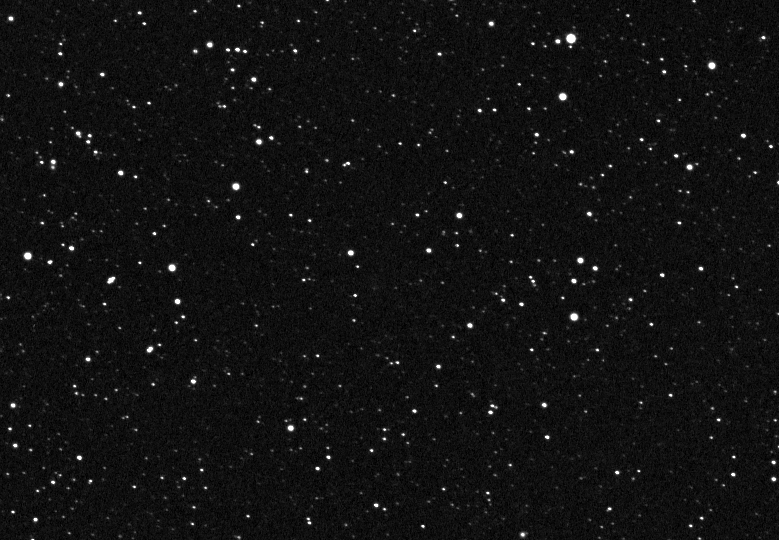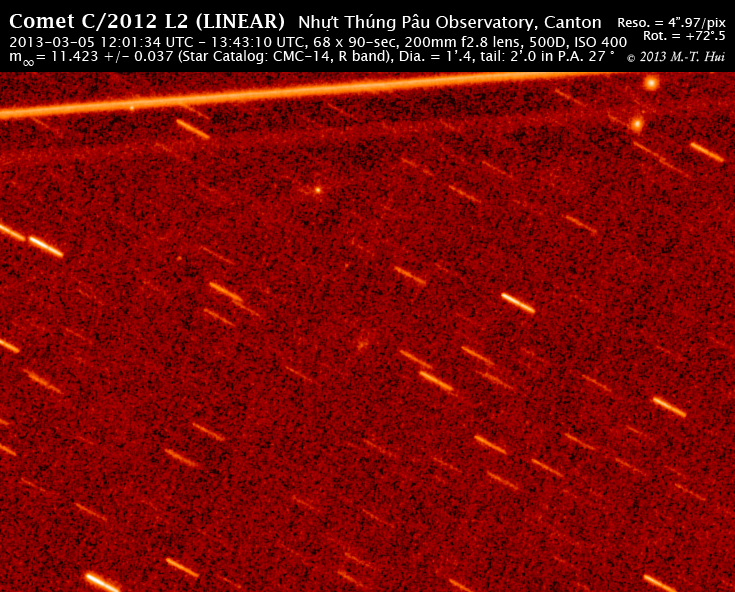Comet
C/2012 L2 (LINEAR)
2013/02/13
2013/03/05
2013 Feb 13
|
A blob of
faint light upper right to the optocenter seems to be an
artifact or a strong noise.
During the
observation, the comet is already placed quite low. High
humidity and some high clouds.
|
|
Animation
displays the motion of the comet. Not all the images were used.
Time stamps
for individual bin 2x2 frames in the animation: 2013-02-13T,
13:16:20 UTC,
13:27:07, 13:37:17, 13:47:27, 13:57:37, 14:07:47, all in UTC.
|
MPC observation computed with Astrometrica
using both UCAC-4 and CMC-14 star catalogs -- the former for astrometric
reduction and the latter for photometric work:
COD
XXX
COM Long. 113 24 50.4 E, Lat. 23 12 47.5 N, Alt. 49m
OBS M.-T. Hui
MEA M.-T. Hui
TEL 0.08-m f/5.6 refractor + CCD
NET UCAC-4
CK12L020 KC2013 02 13.55301 02 06 40.00 +43 38 59.6
13.1 N XXX
CK12L020 KC2013 02 13.56050 02 06 41.09 +43 38 44.6
13.2 N XXX
CK12L020 KC2013 02 13.56756 02 06 42.15 +43 38 30.7
13.4 N XXX
CK12L020 KC2013 02 13.57462 02 06 43.29 +43 38 16.8
13.4 N XXX
CK12L020 KC2013 02 13.58168 02 06 44.42 +43 38 03.6
13.2 N XXX
CK12L020 KC2013 02 13.58874 02 06 45.44 +43 37 48.9
13.1 N XXX
CK12L020 KC2013 02 13.59580 02 06 46.60 +43 37 35.9
12.6 N XXX
Photometry result computed with FoCAs,
which processes images based upon the .LOG file of Astrometrica, by means of
Multibox method:
-
COD
XXX
OBS M.-T. Hui
CATALOG: USNO A2.0 / CMC-14 - BAND: R
10x10 20x20 30x30 40x40 50x50 60x60
SNR SB COD
OBJECT DATE
TIME +/- +/-
+/- +/- +/- +/-
N FWHM CAT
------------ ---------- -------- ----- -----
----- ----- ----- ----- ---- ----
---
C/2012 L2 13/02/2013 13:47:21 13.14
12.42 12.03 11.77 11.60 11.45 5.6
15.3 XXX
C/2012 L2 13/02/2013 13:47:21* 0.24
0.23 0.21 0.19 0.17 0.20
7 21.0 CMC
FoCAs 3.37
www.astrosurf.com/cometas-obs
es.groups.yahoo.com/group/Cometas_Obs
Interpretation of the FoCAs table
headings:
Fisrt line:
OBJECT, DATE, TIME: refering to their original meanings
respectively
10x10, 20x20 ... 60x60: the aperture
sizes of photometry in term of rectangle in arcsec that are used to
measure an object's magnitude
SNR: the Signal-to-Noise Ratio for
aperture photometry
SB: stars of faintest magnitude on the
images used in data reduction with the used star catalog in
Astrometrica, rather than the stars of faintest magnitude in the
images
COD: MPC Code of the observatory
Second line:
+/-:
precisions of measurement
N: the number of used images for
measurement
FWHM: Full-Width-Half-Maximum of total
PSF, relevant to degree of seeing
CAT: the used star catalog in
Astrometrica
Because of the extreme low SNR of the comet,
the photometry produced unpleasantly large residuals. I will keep monitoring the
object, weather permitting.
Copyright @ Man-To
Hui
2013/02/14
2013 Mar 05
|
For color
version please pay a visit to this
page.
During the
observation, the comet is already placed quite low. High
humidity and some fog.
|
Only photometric work has been performed with this session
of observation. The catalog used is CMC-14.
Radius of aperture 0 = 3.0
Radius of aperture 1 = 6.0
Radius of aperture 2 = 9.0
Radius of aperture 3 = 12.0
Radius of aperture 4 = 15.0
Radius of aperture 5 = 18.0
Radius of aperture 6 = 21.0
Radius of aperture 7 = 24.0
Radius of aperture 8 = 27.0
Inner radius for sky annulus = 30.0
Outer radius for sky annulus = 45.0
Sky SkySig SkySkw
Magnitudes
8569.30 14.72 0.01
13.517+-0.045 12.503+-0.034 12.012+-0.032
11.817+-0.035 11.681+-0.040 11.571+-0.044
11.458+-0.048 11.409+-0.055 11.412+-0.064
I applied my IDL routine for calculating the infinite
aperture magnitude of this comet. I obtained $ m_\infty = 11.423 \pm 0.037$,
a good match to results from visual observations during
this time.
Copyright @ Man-To
Hui
2013/03/18
Feel free to e-mail
me with any doubts or questions.
Top
Back...
-- Zurück...
Home


